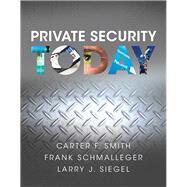For courses in Introduction to Security and Introduction to Private Security.
A global perspective of security issues combined with broad practical coverage of crime prevention strategies.
Private Security Today includes topical coverage that spans the evolution of security, through the present, to the future of the field.To give readers a look at the diverse issues contemporary security professionals face, this globally-focused overview incorporates international components from outside the U.S., as well as a multidisciplinary analysis of the field. Theories are presented in a way that asks readers to consider the balance of individual personal freedoms and public safety for society as a whole. The topics in the text were chosen based on student, professional, and professor recommendations to ensure that the coverage is both relevant and current. Throughout the book, engaging learning tools and real-world examples encourage students to think critically about the state of security today.










